- 02 Oct 2011, 16:37
#2863
Esos “locos” que corren descalzos …. Creo que asi piensan los que me ven a mi, cuando hago mis ”saliditas troteras” …
Aquí uno más, que se une a este modo de correr. Os sigo desde hace un par de meses. Me habéis enganchado de tal manera, que entro todos los días. Paso a contaros mi historia en el apartado de primeros pasos, ya que me consta que ayuda el leer experiencias de los demás. Pues nada, aquí tenéis un descalzo más!!! y continuar escribiendo, que esto llega...
Aquí uno más, que se une a este modo de correr. Os sigo desde hace un par de meses. Me habéis enganchado de tal manera, que entro todos los días. Paso a contaros mi historia en el apartado de primeros pasos, ya que me consta que ayuda el leer experiencias de los demás. Pues nada, aquí tenéis un descalzo más!!! y continuar escribiendo, que esto llega...


